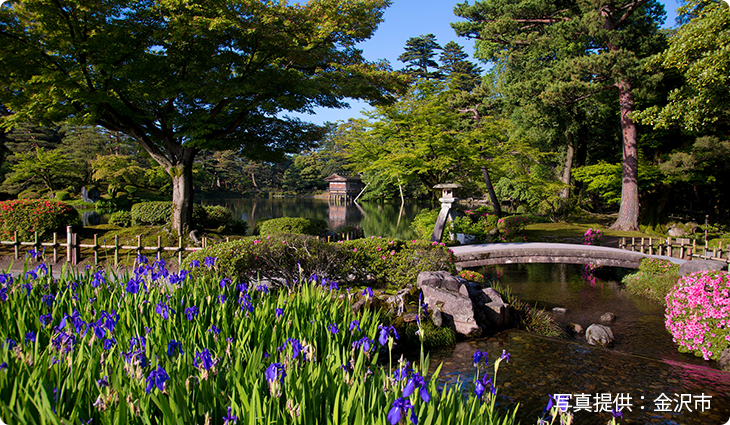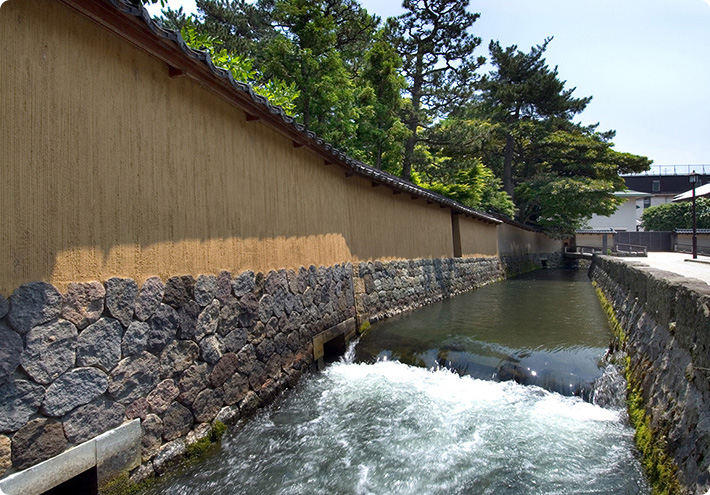

Tourist information on Kanazawa・Toyama area

This area faces the Japan Sea.
Kanazawa is a famous tourist city for its old town, Kenrokuen which is one of Japan’s three major gardens, traditional crafts and culture inherited from the Edo period. Toyama has Tateyama mountains close to Toyama bay. It is also known as a gateway of “Tateyama Kurobe Alpine Route” on the Japan Sea side
Kanazawa
Kanazawa is a leading tourist city where so many tourists visit from around the world. As a great castle town ruled by an influential leader from the 17th century to the second half of the 19th century, Kanazawa has carried on tradition. The city maintained rows of historical houses and Kenrokuen which is one of Japan’s three most beautiful gardens, in addition, various traditional handicrafts and traditional performing arts can be found.
From Shinjuku; take “Hida Takayama Line” on Chuo highway bus, get off at Takayama Nohi Bus Terminal. From Takayama Nohi Bus Terminal; take highway bus for Kanazawa via Shirakawa-go.
- Reservation for Highway bus “Hida Takayama Line” from here (Highway-buses.jp)
- Information about highway bus for Kanazawa from Takayama Nohi Bus Terminal( Nohi Bus)
- Information about Route bus in Kanazawa City ( Hokuriku Railroad )

Kenrokuen is the one of Japan’s three most beautiful gardens located on the heights of the central part of Kanazawa and next to Kanazawa Castle. About 1.7 million people visit the garden every year. Visitors can enjoy the glorious view of seasonal natural and the beauty of the flowers and trees, such as plum and cherry blossoms in spring, azaleas and irises early in summer, and colorful red and yellow leaves in autumn, including the snow-covered landscape with yukitsuri (literally means snow hanging) in winter.
In Kanazawa Castle Park, turrets, gates and gardens have been restored in recent years.
This picture is provided by Kanazawa City
【Access】Take route bus or Kanazawa Loop Bus / Kenrokuen Shuttle from Kanazawa Station and get off at Kenrokuen-shita.

Chaya is a traditional place of feasts and entertainment. The central part of Kanazawa was dotted with a number of chaya houses in the past. These chaya houses were moved into three districts in 1820. The largest one of the chaya districts in Kanazawa is the Higashi Chaya district. The historical rows of this teahouse town have been designated as Japan’s cultural assets. The district includes facilities where you can see the interior of a chaya house that was built 180 years ago. Besides, quite a few old buildings have been renewed into restaurants, teahouses, and souvenir shops, so visitors can enjoy gourmet and shopping.
This picture is provided by Kanazawa City
【Access】Take a route bus or Kanazawa Loop Bus from Kanazawa Station and get off at Hashiba-cho.

Kanazawa was a castle town of the Kaga Clan. The residences of chief retainers of the Kaga Clan were located in the Naga-machi area, where top and middle class Samurais lived. The alleys and the mud walls of nagayamon gates (row house gates) still maintain the sight of the old days, citizen life is still being carried out in the area.
If you take a stroll along the walls, water, and the remaining stone pavement, the atmosphere at that time is felt.
This picture is provided by Kanazawa City
【Access】Take route bus or Kanazawa Loop Bus / Kenrokuen Shuttle from Kanazawa Station and get off at Korinbo.

Myoryuji Temple was built as a prayer place of the Kaga Clan. Later, Kaga Clan added a number of functions to the temple so that it would work as a lookout post and fort to prepare for invasion of enemy. In order to fool the enemy, the temple has many hidden chambers and stairs. That is why this temple is also called Ninja Temple.
This picture is provided by Kanazawa City
【Access】Take route bus from Kanazawa Station and get off at Hirokoji.
Toyama
Northern Alps Tateyama Mountain range rises along the southeastern border of Toyama prefecture, and Toyama bay faces the sea on the north. Toyama thrived as a port town of Japan Sea route. It is also known as the entrance of Tateyama Kurobe Alpine Route on the Japan Sea side.
From Shinjuku; take “Hida Takayama Line” on Chuo highway bus, get off at Takayama Nohi Bus Terminal . From Takayama Nohi Bus Terminal ; take highway bus for Toyama via Shirakawa-go.
- Reservation for Highway bus “Hida Takayama Line” from here (Highway-buses.jp)
- Information about highway bus for Toyama from Takayama Nohi Bus Center( Nohi Bus)
- Information about transportation in Toyama City(Toyama Chihou Railway)

In 1954, Industry Expo of Toyama is held to commemorate the completion of war-damage reconstruction. It is a building imitating a 4-story castle, and has been popular as a museum to introduce the history and culture of the region for a half century .
【Access】Walk from Toyama Station
Tateyama Kurobe Alpine Route
【To Nagano side entrance】
From Shinjuku; take “Azumino Hakuba Line” on Chuo highway bus, get off at Ogisawa
【To Toyama side entrance】
Take Toyama Chihou Railway, from Dentetsu Toyama Station, and get off at Tateyama Station.

The Tateyama Kurobe Alpine Route is known as the “Roof of Japan”, the most famous mountain sightseeing route in Japan. The route passes through the dynamic scenery of Mt. Tateyama of the Japan Alps. The route is approximately 90 km long lie between Nagano Prefecture and Toyama Prefecture. It is traversed using a variety of vehicles, such as trolley bus and ropeway, with an elevation change of 2000 meters. You will be impressed by the variety of scenery that can be seen in different seasons. Kurobe Dam the highest arch dam in Japan, Daikanbo Station has outstanding view from the second floor and observation deck atop the station. Muroto is the highest point on the route, there are many places that you can take a walk to.

